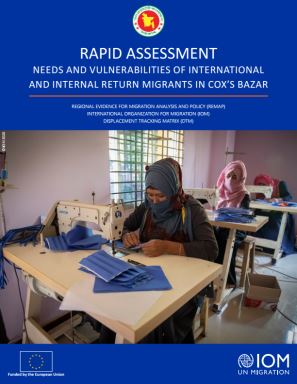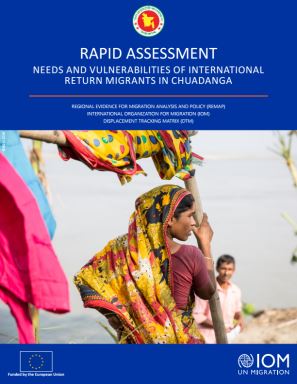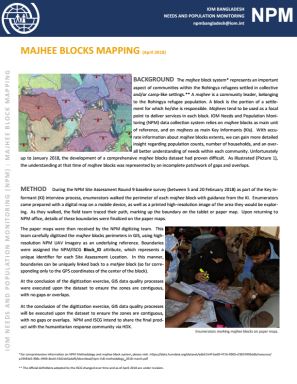-
Countries
-
Data and Analysis
-
Special Focus
-
Crisis Responses
Bangladesh
Bangladesh
Suivi des PDI
Mouvements de déplacement
426,000
IDMC 2023
cycle de collecte de données
À propos Bangladesh
IOM Bangladesh Needs and Population Monitoring (NPM) tracks population numbers, movements and needs to inform the Rohingya humanitarian response in Cox Bazar. IOM Bangladesh Needs and Population Monitoring (NPM) is part of IOM’s global Displacement Tracking Matrix (DTM) programming. DTM is IOM’s information management system to track and monitor displacement and population mobility. It is designed to capture, process, and disseminate information to provide a better understanding of the movements and evolving needs of displaced populations, whether on-site or en route regularly and systematically. IOM Bangladesh NPM was first launched in Cox’s Bazar district in early 2017 and has consistently been a key data provider in the Rohingya humanitarian response. Access the NPM Portal for the most recent products.
IOM’s Needs and Population Monitoring (NPM) unit works to support evidence-based humanitarian decision-making and prioritization by tracking needs and vulnerabilities among both Rohingya and the host communities in Cox’s Bazar. Through NPM’s broad information management framework, service providers can access and make use of comprehensive data and analysis on the needs and vulnerabilities of affected populations, promoting more informed and nuanced humanitarian programming. NPM successfully partners and cooperates with the Inter-Sector Coordination Group (ISCG), various sectors, such as Shelter and Camp Coordination and Camp Management (SCCCM), and humanitarian partners, particularly through designing and conducting a wide range of assessments and providing ad-hoc data collection services, as well as technical information management and GIS with Drone support. In addition. Since 2018, REACH Initiative and NPM closely collaborating in the implementation of the Multi-Sectoral Needs assessments in Rohingya refugee camps and host communities. NPM has also provided field and contextual expertise to Ground Truth Solutions and Translators without Borders. These partnerships serve to strengthen NPM as a key information provider of the response.
Since 2018, IOM, with funding from the European Union, established the Displacement Tracking Matrix Regional Evidence for Migration Analysis and Policy (DTM REMAP) project, to strengthen the evidence-based formulation and implementation of humanitarian and development policy and programming on human mobility, migration, return and displacement in Bangladesh. Under DTM REMAP, IOM Bangladesh conducts various activities in a variety of districts in Bangladesh including: i) Baseline Mobility Assessments (BMA) to inform on numbers and locations of Bangladeshi internal and international migrants; ii) Survey on Drivers of Migration (SDM) to improve the understanding of the drivers of out-migration among Bangladeshi (potential) migrants; iii) Returnee Longitudinal Studies (RLS) to monitor the sustainability of return and needs and vulnerabilities of returnees; iv) Community Based Needs Assessments (CBNA) to inform on characteristics, needs and vulnerabilities of Bangladeshi migrants and their communities.
Bailleurs de fonds
- European Union
- Australia
- PRM
- DFID
Bangladesh – Rapid Assessment: Needs And Vulnerabilities Of International and Internal Return Migrants In Satkhira (May-June 2020)
In May and June 2020, IOM, supported by the European Union under the regional program REMAP, along with the NPM team based in Cox’s Bazar, completed data collection on the needs and vulnerabilities of international and internal migrants that returned to Bangladesh during the global COVID-19
Bangladesh – Rapid Assessment: Needs And Vulnerabilities Of International and Internal Return Migrants In Cox’s Bazar (May-June 2020)
In May and June 2020, IOM, supported by the European Union under the regional program REMAP, along with the NPM team based in Cox’s Bazar, completed data collection on the needs and vulnerabilities of international and internal migrants that returned to Bangladesh during the global COVID-19
Bangladesh – Rapid Assessment: Needs And Vulnerabilities Of International Return Migrants In Dhaka (May-June 2020)
In May and June 2020, IOM, supported by the European Union under the regional program REMAP, along with the NPM team based in Cox’s Bazar, completed data collection on the needs and vulnerabilities of international and internal migrants that returned to Bangladesh during the global COVID-19
Bangladesh – Rapid Assessment: Needs And Vulnerabilities Of International Return Migrants In Cumilla (May-June 2020)
In May and June 2020, IOM, supported by the European Union under the regional program REMAP, along with the NPM team based in Cox’s Bazar, completed data collection on the needs and vulnerabilities of international and internal migrants that returned to Bangladesh during the global COVID-19
Bangladesh – Rapid Assessment: Needs And Vulnerabilities Of International Return Migrants In Chattogram (May-June 2020)
In May and June 2020, IOM, supported by the European Union under the regional program REMAP, along with the NPM team based in Cox’s Bazar, completed data collection on the needs and vulnerabilities of international and internal migrants that returned to Bangladesh during the global COVID-19
Bangladesh – Rapid Assessment: Needs And Vulnerabilities of International Return Migrants in Chuadanga (May-June 2020)
In May and June 2020, IOM, supported by the European Union under the regional program REMAP, along with the NPM team based in Cox’s Bazar, completed data collection on the needs and vulnerabilities of international and internal migrants that returned to Bangladesh during the global COVID-19
Bangladesh – Rapid Assessment: Needs And Vulnerabilities of International Return Migrants in Brahamanbaria (May-June 2020)
In May and June 2020, IOM, supported by the European Union under the regional program REMAP, along with the NPM team based in Cox’s Bazar, completed data collection on the needs and vulnerabilities of international and internal migrants that returned to Bangladesh during the global COVID-19
Bangladesh – Rapid Assessment: Needs and Vulnerabilities of Internal Return Migrants in Kurigram (May-June 2020)
In May and June 2020, IOM, supported by the European Union under the regional program REMAP, along with the NPM team based in Cox’s Bazar, completed data collection on the needs and vulnerabilities of international and internal migrants that returned to Bangladesh during the global COVID-19
Bangladesh — Rapid Needs Assessment (July 2020)
As the COVID-19 pandemic emerged globally, migrant workers, both internationally and within Bangladesh, found themselves facing a new set of challenges and vulnerabilities.
Jul 20 2020
Bangladesh — Rapid Needs Assessment (July 2020)
Bangladesh – Survey on Drivers of Migration (REMAP 2019)
One key finding of the report is that Bangladeshi regular and irregular potential migrants share many characteristics. Regular and irregular potential migrant respondents were the same ages and had similar levels of education and employment prior to the decision to migrate.
Bangladesh – Mobility Tracking Observation Report (30 March-15 April 2020)
In Bangladesh many individuals migrate from their home villages for work. When the public holiday and mobility restrictions went into effect on 26 March 2020, due to the outbreak of COVID-19, many of these individuals returned to their districts of origin.
Bangladesh – Rohingya Response: Health Behaviours & COVID-19 (3 April 2020)
The 855,000 Rohingya Refugees currently residing in 34 makeshift camps in Cox’s Bazar, Bangladesh are highly vulnerable to COVID-19.
Bangladesh — Site Profiles, Round 12 (23 September — 10 October 2018)
This multi-sectoral needs assessment has been designed in cooperation with ISCG and all sectors. It provides an overview of the Rohingya refugee population's distribution, needs and access to services at the end of the rainy season.
Bangladesh – Teknaf Para Mapping Methodology (May 2018)
The Site Management sector, with the support of SM partners (IOM, UNHCR, ADRA and Solidarités International) conducted a mapping exercise during the months of April and May 2018 in the areas of Teknaf upazila currently hosting Rohingya refugees.
Bangladesh – Teknaf Para Mapping (14 June 2018)
The Site Management sector, with the support of SM partners (IOM, UNHCR, ADRA and Solidarités International) conducted a mapping exercise during the months of April and May 2018 in the areas of Teknaf upazila currently hosting Rohingya refugees.
Jul 04 2018
Bangladesh – Teknaf Para Mapping (14 June 2018)
Bangladesh – Site Assessment Methodology (March 2018)
IOM Bangladesh Needs and Population Monitoring (NPM) is part of the IOM’s global Displacement Tracking Matrix (DTM) programming, first launched in Cox’s Bazar district, Bangladesh in Spring 2017.
Bangladesh – Thematic maps NPM Round 10 (June 2018)
The following document includes 12 thematic maps with information on the following topics: Population density, Cooking fuel source, Education barriers for girls, Access to health facilities, Income source, Most severe needs, NFI distribution, Primary safety concern, Sheleter types, Community
Bangladesh — NPM Site Maps Cox's Bazar (31 May 2018)
The Site Management sector, with the support of SM partners (IOM, UNHCR, ADRA and Solidarités International) conducted a mapping exercise during the months of April and May 2018 in the areas of Teknaf upazila currently hosting Rohingya refugees.
May 31 2018
Bangladesh — NPM Site Maps Cox's Bazar (31 Ma…
Bangladesh — NPM ACAPS Analysis Hub Situation Overview Site Assessment 10 (May 2018)
The traffic lights diagram is based on the results of a multi-sector prioritisation tool developed by the Analysis Hub. The tool uses NPM data from five sectors to prioritise needs geographically, at the block level.
Bangladesh — Site Assessment, Round 10 (May 2018)
In the assessment conducted between 1 and 20 May 2018, an estimated 915,000 individuals (approximately 215,000 households) were identified in 1,922 locations.
Bangladesh — Needs and Population Monitoring Report, Majhee Blocks (April 2018)
The majhee block system represents an important aspect of communities within collective and/or camp-like settings where Rohinya refugees have settled.
Bangladesh – NPM Methodology (March 2018)
IOM Bangladesh Needs and Population Monitoring (NPM) is part of the IOM’s global Displacement Tracking Matrix (DTM) programming. DTM is IOM’s information management system to track and monitor population displacement during crises.
Apr 26 2018
Bangladesh – NPM Methodology (March 2018)
Bangladesh — Site Assessment, Round 9 (March 2018)
In the assessment conducted between 7 and 25 March 2018, an estimated 898,000 individuals (approximately 211,000 households) were identified in 1,807 locations.
Bangladesh — Site Profiles, Round 9 (March 2018)
IOM Bangladesh Needs and Population Monitoring (NPM) regularly and systematically captures and disseminates information regarding the movements and evolving needs of populations on the move, whether on site or en route.
Apr 14 2018
Bangladesh — Site Profiles, Round 9 (March 2018)


























